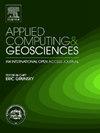Comparison of three one-dimensional time-domain electromagnetic forward algorithms
IF 3.2
Q2 COMPUTER SCIENCE, INTERDISCIPLINARY APPLICATIONS
引用次数: 0
Abstract
Accurate, efficient, and accessible forward modeling of geophysical processes is essential for understanding them and for inversion of geophysical data. Various algorithms are available for predicting data with the time domain electromagnetic method (TDEM). These algorithms differ in their approach and implementation, making some more suitable than others for specific applications. In this study, we compare three different algorithms for calculating the solution to the 1D forward response problem in TDEM, provided by Geoscience Australia, AarhusInv and SimPEG. Our comparison focuses on four main aspects: efficiency, accuracy, generality and convenience. Efficiency is evaluated from the perspective of computational speed. Accuracy is evaluated in two steps. First, we analyze the relative modeling error of each algorithm’s forward calculation for conductive half-space models, compared to an analytic solution. Secondly, we evaluate the accuracy of the algorithms relative to each other in the context of more complex earth models where no analytic solutions exist. This evaluation assumes a realistic TDEM instrument. Generality is the ability to model a variety of real TDEM scenarios. Lastly, we assess the convenience of each algorithm by considering factors such as ease of use, extensibility, code accessibility, and licensing requirements. We find that no single tested forward algorithm is best for all cases. AarhusInv is accurate and fast while it also has the most options for modeling real TDEM systems, but it requires a license, and is the hardest forward algorithm to interface to. SimPEG is open source, fast, easy to install and results may easily be shared, but has accuracy limitations at early times when modeling real systems with gate integration and low-pass filters. Lastly, Geoscience Australia is open source, accurate, and fast, but can only model dipole sources.
三种一维时域电磁正演算法的比较
准确、高效、方便的地球物理过程正演模拟对于理解地球物理过程和反演地球物理数据至关重要。时域电磁法(TDEM)预测数据的算法有很多种。这些算法在其方法和实现上有所不同,使得一些算法比其他算法更适合特定的应用程序。在这项研究中,我们比较了三种不同的算法来计算TDEM中1D正演响应问题的解,这三种算法分别由澳大利亚地球科学、AarhusInv和SimPEG提供。我们的比较主要集中在四个方面:效率、准确性、通用性和方便性。效率是从计算速度的角度来评价的。准确度的评估分两步进行。首先,与解析解相比,我们分析了每种算法对导电半空间模型的正演计算的相对建模误差。其次,在没有解析解的更复杂的地球模型中,我们评估了算法相对于彼此的准确性。这个评估假设了一个现实的TDEM仪器。通用性是对各种真实的TDEM场景进行建模的能力。最后,我们通过考虑诸如易用性、可扩展性、代码可访问性和许可要求等因素来评估每种算法的便利性。我们发现没有一种经过测试的前向算法对所有情况都是最好的。AarhusInv是准确和快速的,同时它也有最多的选择来建模真实的TDEM系统,但它需要许可证,是最难接口的前向算法。SimPEG是开源的、快速的、易于安装的,并且结果可以很容易地共享,但是在早期使用门集成和低通滤波器对真实系统建模时存在精度限制。最后,澳大利亚地球科学是开源的、准确的、快速的,但只能模拟偶极子源。
本文章由计算机程序翻译,如有差异,请以英文原文为准。
求助全文
约1分钟内获得全文
求助全文
来源期刊

Applied Computing and Geosciences
Computer Science-General Computer Science
CiteScore
5.50
自引率
0.00%
发文量
23
审稿时长
5 weeks
 求助内容:
求助内容: 应助结果提醒方式:
应助结果提醒方式:


